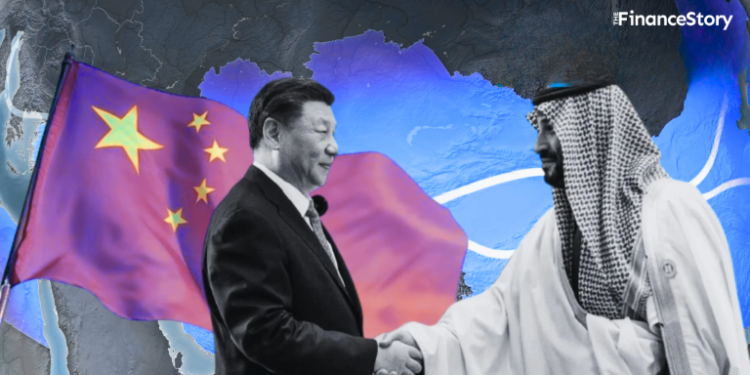- For years, China and the Middle East have been strong trading partners, with annual commerce topping $400 billion.
- But something new is happening…
- According to a fresh PwC Middle East report, more and more Chinese companies are setting up offices, factories, and headquarters there.
- The takeaway? China isn’t just trading with the region anymore; it’s building a second home there.
Here’s the story in plain words
PwC surveyed 136 Chinese businesses operating in the region and here’s what they found:
- Nearly 90% Chinese firms plan to expand further in the region
- 1 in 3 firms now earn at least 20% of their global revenue here, a huge jump since 2022
- 77% of Chinese firms have shifted from having just representative offices to full-scale, local entities (i.e. real operations on the ground).
What’s even more interesting is that Chinese companies aren’t sticking to one country anymore.
Nearly 30% of them operate in five or more Middle Eastern countries like Egypt, Qatar, and Kuwait.
This shows a shift from “single-country bets” to multi-market strategies.
Why the Middle East?
So, half of Chinese firms now say the Middle East is a “better business environment” than other regions as governments make big reforms:
- Saudi Arabia: New laws make investing easier.
- UAE: 100% foreign ownership is now allowed.
- Egypt: Special priority zones for investors.
- Kuwait & Bahrain: Foreign firms can now bid directly on government projects.
UAE vs. Saudi Arabia
The Gulf is the hot spot.
According to PwC:
- 84% of Chinese companies are active in Saudi Arabia.
- 79% are in the UAE.
But when it comes to setting up headquarters, the UAE takes the crown:
- 65% of Chinese regional HQs are in the UAE
- Saudi Arabia comes second with 40%
- Egypt is third with 10%.
Why the UAE? It’s simple: strong infrastructure, easy business rules, and liberal laws.
Chinese firms are pumping billions into hubs like Dubai International Financial Centre (DIFC), which is becoming popular with Chinese financial institutions.
Reports suggest Big Chinese banks are setting up in DIFC and Chinese entities make up over 30% of DIFC’s banking & capital markets assets.
Also read: Middle East crucial to the global and Indian economies?
Yes, profits are rising
And this expansion is paying off.
- 40% of Chinese firms in the region are profitable.
- Loss-making firms have dropped to just 15% in 2025, down from 21% in 2022.
- Over 60% of investors say they’re satisfied with their business in the region.
New Industries & Strategies
What’s changing is also what kinds of business Chinese firms are doing. It’s not just energy or manufacturing anymore.
There’s strong interest in digital technologies, AI, renewable energy, green tech, biopharma, and high-tech infrastructure.
These align well with Middle Eastern countries’ own plans (Saudi Vision 2030, the UAE’s push to diversify from oil, and investment in green projects).
That means Chinese firms are not just chasing profits, they’re fitting into the region’s long-term plans.
Shifting customers
Traditionally, Chinese businesses in the Middle East focused on government clients.
But that is changing.
Today, half of them also serve local private companies, up from 44% just two years ago.
The shift toward the private sector shows that their customer base is diversifying.
The bigger picture…
Behind all this expansion is China’s Belt and Road Initiative (BRI), also known as the “New Silk Road.”
Launched in 2013, it’s China’s global plan to invest in infrastructure like roads, ports, energy projects, and digital networks in other countries.
It’s a way for China to boost trade, strengthen relationships, and create opportunities for Chinese companies abroad.
In fact, by 2024, the Middle East became the top BRI destination, attracting $39 billion.
Some examples of BRI investments in the Middle East:
- Saudi Arabia received nearly $19 billion, including a $5.6 billion subway project in Riyadh.
- Iraq got $9 billion, including an $8 billion oil refinery project.
- UAE hosts over 15,500 Chinese companies and received $3.1 billion in BRI-linked investments in 2024.
You might wonder: why would China spend so much building infrastructure for other countries?
The answer is that it makes money while doing it.
- Chinese companies are hired to design, build, and operate these projects, earning fees and generating revenue.
- Chinese banks often provide loans for the projects, which are paid back over time with interest.
- On top of that, many projects include long-term contracts for maintenance, operations, or management, creating ongoing income.
- It’s also strategic. By building key infrastructure, China strengthens trade routes, secures supply chains, and establishes a strong business presence.
Also read: PwC Middle East to create over 1,000 job opportunities over the next 3 years.
But why is the Middle East turning to China
Historically, Europe and the U.S. were the Middle East’s main partners, especially in sectors like oil, infrastructure,
Over the past two decades, China has emerged as a competitor.
But why?
- Quickly deliver massive projects while Western firms move more slowly.
- Through the Belt and Road Initiative, China offers long-term partnerships and is willing to build, operate, and finance projects, not just supply goods.
- Chinese banks provide long-term loans and project execution, unlike Western firms that demand upfront payments or higher margins.
- China also brings trade and technology, including AI, digital networks, and renewables, helping the Middle East diversify from oil.
- On top of that, China’s political neutrality in regional conflicts reduces risks for long-term investments.
Wrapping up…
Despite the momentum, challenges remain, including requests for tax incentives, regulatory clarity, and governance efficiency, and setting up local operations still demands significant time and investment.
But the trend is clear: China’s presence in the Middle East is here to stay.
Linda Cai, Inbound/Outbound Leader, PwC China, said: “Chinese enterprises are no longer treating the Middle East as an exploratory market; it has become a strategic hub for global growth.”
FAQs
Why are Chinese companies expanding beyond trade in the Middle East?
Governments in Saudi Arabia, the UAE, and Egypt are reforming laws, opening sectors like AI, renewables, and biopharma, and offering incentives such as 100% foreign ownership and special economic zones.
For Chinese firms, it’s a chance to embed themselves in long-term projects and tap into diversified revenue streams.
What challenges remain for Chinese companies in the region?
Local regulations can be unclear, tax incentives are still limited, and governance standards vary. Setting up full-scale operations, not just rep office,s requires significant investment and time.
To succeed, Chinese companies must navigate local compliance, adapt to new customer bases, and build deeper relationships beyond government contracts.










